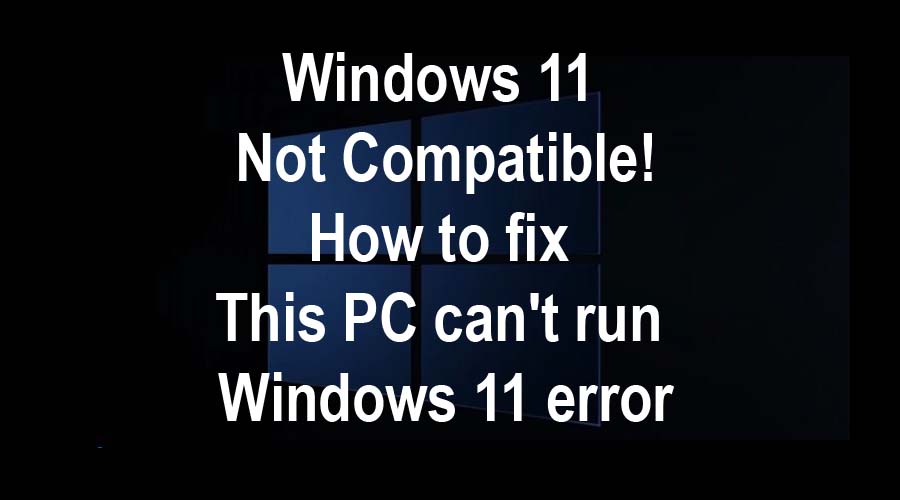Windows 11 not compatible! How to fix This PC can’t run Windows 11 error TPM and secure boot? With TPM and Secure Boot, we have found some ways to fix the annoying Windows 11 installation error. How to fix the problem.
If you have determined that your PC is incompatible with Windows 11, it may be because two security settings are not enabled on your system, Secure Boot and TPM 2.0. This is how you do it. Microsoft kicked off Windows 11 earlier this year with a preview version of its flagship operating system. However, if you try to use the old version of the software on your existing PC, you may run into some obstacles due to the system requirements for the new operating system. Here’s how to download Windows 11 and create an install drive for Windows 11.
If you’ve tried installing Windows 11 Insider Preview or using the Microsoft PC Health Check app and received the “This PC cannot run Windows 11” error message, two important security settings that may be on your system that are not activated: Secure Boot and TPM 2.0. Here are two other things to do before downloading Windows 11. Many modern computers and processing chips from Intel and AMD have these features built-in, and both are now required for all computers running Windows 11.
Windows 11 Not Compatible
Facing Windows 11 not compatible problems? After downloading the PC Health Check app, you can click Check Now to start the scanning process. The app will tell you if your computer is running Windows 11 or what’s missing, and you can click View All Results for more information. If your computer is new enough to support both, enabling TPM short for Trusted Platform Module and Secure Boot is usually fairly straightforward. No special skills are required and just click on the menus. If you’ve never heard the words “BIOS menu” before, you might not be in your element, but don’t be intimidated. With a little patience, any beginner can do this.
Secure Boot is a feature of your computer software that controls the operating systems that may be active on the computer. This is a good thing and a bad thing for a Windows machine. On the one hand, it can prevent certain classes of invasive malware from taking hold of your computer and is a key defense against ransomware.
On the other hand, it may prevent you from installing a second operating system on your computer so that you can choose between two when you turn on your computer for the first time. So if you want to experiment with Linux operating systems, for example, Secure Boot can stop you. Secure Boot also plays an important role in preventing Windows hacking.

How to fix This PC can’t run Windows 11 error
Now that you know the safe technologies you will be using, there are a few things to consider before you start to troubleshoot the problem on your own. Microsoft has confirmed that there are four types of issues that cause the “This PC can’t run Windows 11” error message to appear when using the PC Health Check tool. If you do not have the necessary hardware or firmware to run Windows 11, the following instructions will not help you; You need to buy a new device to run the operating system. Please note that these instructions are written as widely as possible. This is because Windows computers are so different that it is not possible to cover all options for enabling TPM and Secure Boot on all devices.
Most of the time, however, the process is similar enough on all machines that you can use the instructions as a guide, and if your computer differs, you can still identify the correct menu or label on your own system. If your device is still covered by a warranty, always talk to the manufacturer before doing anything that might void it. If your business or school owns and maintains your computer, it may have unique security settings that your IT staff must manage. It is also a good idea to contact your local PC repair center. If you turn around or run into obstacles, a trained professional is the best way to get you back on track. Always back up your important files before making any major changes to your computer. Always. Do it. You will thank us later.
Windows 11 Bugs And Windows 11 Errors | Windows 11 Insider Preview Bugs
If this is your first time working in a BIOS menu, follow the instructions and don’t stray too far from the beaten path. We have a very simple mission here, and nothing I recommend below will harm your computer or data, but changing the firmware settings in your BIOS menu can be powerful. There are few security measures here and you can lose a lot of important data very quickly. Some errors can be permanent, and in most cases, you won’t see any pop-up windows asking if you really want to make these errors. You should definitely shop around, explore your options, and familiarize yourself with what’s behind the hood, but avoid changing any settings or saving those changes unless you know exactly what’s going on when you do that.
Does my device support TPM 2.0 and Secure Boot?
Windows 11 not compatible and If PC Health Checker suggests that TPM is not on, the first thing to do is find out if this is an accurate diagnosis. This is how you do it.
1. At first on your desktop, press the Windows key next to the space bar + R. This will open a dialog box.
2. Then type tpm.msc in the field text box and press Enter. This should open a new window titled “TPM Management on Local Computer”.
3. Now click Status. If you see the message “The TPM is ready for use”, it means that PC Health Checker has been misdiagnosed and the following steps will not help you. At this point, there are a number of reasons why you may receive a fake error message from Microsoft, so it is best to have a professional look on your computer.
If you don’t see this message and instead see “The supported TPM could not be found” or some other message that the TPM may be disabled, try the following steps.
How do I Enable secure boot?
Keeping one thing in mind while activating Safe Boot will save you headaches. After enabling Safe Boot on a computer running software incompatible with Safe Boot, the computer sometimes refuses to properly load Windows on restart. If this happens, don’t panic. You haven’t broken anything.
No matter what method you used to access the Start menu, whether it was through the Windows 10 Start menu or the traditional method of pressing a specific key during the boot process, you can still use the traditional method to go back to the start menu and start disabling the security feature again.
Using the Windows 10 Start menu
Follow the steps above to access UEFI firmware settings.
1. Once you are in UEFI, it will search for secure boot settings. This can be done in several places: Check the tabs labeled Startup, Security, or Authentication.
2. After examining the tabs and finding the Safe Boot setting, slide the switch next to toggle it on or off.
3. Look for the Save function and after you save the changes and exit the menu, your computer should restart and return to the normal Windows desktop.
There are some PCs where you might not be able to easily find the Safe Boot setting. Some computers load secure startup keys in a custom tab. On some computers, you cannot enable Secure Boot until certain factory settings are restored. If you can’t access Safe Boot or get stuck here, it’s better to seek professional help than to risk.
From start-up
If you are not working with UEFI, you should be able to enable Secure Boot in BIOS.
1. As you did when you turned on your TPM, press F2 (or whatever your manufacturer says) while your computer is booting up and go to the BIOS menu.
2. Navigate to the tab or option that displays the BIOS settings, and then select Advanced.
3. Next, choose Boot Options and a list of them should appear.
4. Look for Secure Boot in this list. Allow him.
5. Press Save, exit the menu system, and restart your computer if it does not restart automatically.
How to Enable TPM 2.0?
You need to go to your BIOS menu to access your TPM switch and there are two ways to do this. We’ll cover both here. The first is for much newer PCs and the second for those a few years older. Whichever you choose, you will need to restart your computer. So save your work and close any open windows or programs before continuing. Windows 11 not compatible follow the steps to enable TPM 2.0;
Using the Windows 10 Start menu
If you have a newer computer running Windows 10, your boot time may be too fast for you to try the traditional method of pressing a specific key to access your BIOS menu before Windows can fully load. Here’s how to access it from your normal desktop.
1. Start your computer normally and open the Start menu by clicking the Windows button in the lower-left corner of the screen. Click the gear-shaped settings icon on the left side of the menu.
2. In the Settings window that appears, click Update & Security. In the left side panel that appears, click Recovery. Under the Advanced startup heading, click Restart now. Your computer will restart immediately and instead of restarting it and redirecting you to your normal desktop screen, you will be taken to a blue screen with a few options.
3. Click Troubleshoot, then Advanced Options, then UEFI Firmware Settings. Your device will restart. From there, go to step 2 in the next section and follow the remaining steps.
From start-up
Windows 11 not compatible? This should be very quick for step 1. You only have a few seconds to enter BIOS before your operating system loads. If you lose your window, no problem, just restart your computer and try again. However, after step 1 you can take your time.
1. Restart your computer and when it boots you should see a message asking you to press a certain key to enter BIOS, whether you use that word or any other word. For example, most Dell would say “Press F2 to open settings”. Other messages can be “Configuration = Del” (which means delete) or “System Configuration: F2”. Press any key indicated by the message and enter the configuration menu.
Depending on your type of computer, you may need a different password to access the setup menu. It can be F1, F8, F10, F11, delete or another key. If no instructional message appears on the screen, a general rule of thumb is to press the key when the manufacturer’s logo appears, but before Windows loads. To find out which key to enter, search online for the make and model of your laptop computer and the term “BIOS key”.
2. There must be at least one option or tab in the BIOS or UEFI menu titled Security. Navigate there with your keyboard and press Enter. On some systems, you may need to use the + key to expand a submenu.
3. Once you are in the Security section, it will search for TPM settings. This could be clearly labeled “TPM Device”, “TPM Security” or some other variation. It is sometimes referred to as “PTT” or “Intel Trusted Platform Technology” on Intel computers. It may also appear as “AMD fTPM switch”.
Windows 11 ISO Download 32 Bit And 64 Bit | Quick Installation Guide
Attention: Stay up to date here. Most of the TPM configuration menus usually give you the option of erasing, updating, or resetting your TPM to factory defaults. Don’t do this now. If you delete the TPM, you will lose all data encrypted by the TPM and all encryption keys. This action cannot be undone or undone.
4. In the TPM configuration menu, your only task is to find the switch that activates the TPM. They don’t touch anything else. In the options in that menu, look for an option that shows a way to turn it on or to toggle it next to the word “On” or “Not available,” or even just “Off.” Use the arrow keys to activate this switch or toggle.
5. After enabling TPM, find Save on the screen. After saving these settings, restart your computer.
What if I don’t have a TPM chip – Windows 11 not compatible
Motherboard makers sometimes save on installing the actual TPM chip and only ship boards with the part that allows the chip to connect to the card. If while purchasing your PC you find that your TPM chip is shorted and you don’t have a firmware version or virtual TPM, you still have a few options. Your first option is to try to return your device beyond the manufacturer’s warranty. Provided of course that your machine builder is ready to install the chip already sold or to replace your model with a chip by a chip. Your second and more expensive option is to simply buy a newer machine after making sure it does have a real TPM 2.0 chip.
If your warranty has already expired, your third, cheaper but potentially more difficult option is to buy a new motherboard with a TPM 2.0 chip installed, then change the boards yourself or ask your local repair shop to sell them. order work. However, keep in mind that the current global shortage of chips has reduced the supply of motherboards around the world, making them harder to find and pushing prices above $ 300-450 for some brands. Your on-site workshop can also help you here.
Finally, you or your repair shop can try your fourth option: find and install a TPM chip with the correct specifications for your motherboard. Depending on what type you choose and where you get it from, a TPM 2.0 compatible chip can cost anywhere from $ 70 to $80. Fortunately, the basic structures of circuit boards and chips are similar enough that it is possible to install a TPM chip. yourself if you want to get your hands dirty under the hood. ZDNet offers step-by-step instructions (with a helpful image gallery to walk you through).
Whichever route you choose, we strongly recommend that you consult your manufacturer or an equipment repair specialist before attempting to disassemble your machine. Spending a few moments with an experienced professional can be enough to turn your upgrade nightmare into a quick fix and save you from excessive replacement costs. So that’s all about Windows 11 not compatible. And How to fix This PC can’t run Windows 11 error TPM and secure boot.






